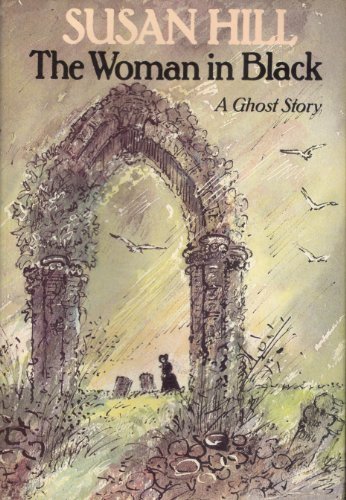What’s a reader to do when a ghost story is the embodiment of “The Ghost Story”? If it ticks off every requirement–old, isolated house; sullen villagers; gloomy weather–does that make it “the best” ghost story? I might once have insisted that, yes, a ghost story that meets all of the criteria (whatever the list might be) is in fact the best of its genre. (The hubris of youth!) Having read Susan Hill’s The Woman in Black, I’m forced to concede that perhaps there is more to a ghost story than spooks, moors, and crisp English diction. I’m reminded of the words of a comic book writer, who advised teenagers aspiring to his role, “If you only read comic books, you might write the best comic book ever written, but you’ll never write anything different.”
The Woman in Black begins, appropriately enough, on a Christmas Eve sometime in the early decades of the twentieth century. Arthur Kipps’ second wife and his step-children sit around the fire, telling one another ghost stories. Here we have already satisfied one criterion of a ghost story: It must be set in England. Certainly, every culture in every time and place has spoken of ghosts, but “the best” ghost story can only be set in England. Bonus: By beginning her tale on Christmas Eve, Hill tips her hat to the fine English tradition of telling ghost stories on that most-anticipated evening of the year. More spooky stories by the fire, fewer fat men and elves!
Kipps is agitated as his family’s stories grow grislier and more ridiculous. As his children’s merriment increases, his declines. Urged by his step-sons to join in the fun, Kipps storms off in a huff. Staring at the clear night sky, he is reminded of events through which he suffered as a younger man, a trauma he has worked hard to put behind him. He resolves to write it down in its entirety, a purge that becomes Hills’ larger narrative, the ghost story “proper.”
The action commences with Kipps dispatched on legal business to a small village a day’s train ride outside of London. Kipps, stymied in his career aspirations, gladly takes on what his elder partner perceives as an imposition. In addition to seeking refuge from his humdrum duties as a solicitor, Kipps flees the London weather, characterized by many days of fog so dense it made travel within the city dangerous. Kipps sallies forth to put in order the estate of the recently deceased Mrs. Drablow of Eel Marsh House. Read those names again: That is some heavy handed foreshadowing going on there.
En route to Eel Marsh House, Kipps encounters what you might expect from the villagers, which is to that they seem to know something about Eel Marsh House, but are unwilling to talk about it, to Kipps’ growing frustration. The local lawyer, Kipps’ contact, is thrown into paroxysms of fear when, at Mrs. Drablow’s funeral, Kipps confesses to having seen the eponymous “Woman in Black.” Kipps nevertheless proceeds, as an ambitious and sensible young man is likely to do, to head to Eel Marsh House, which, sitting in the middle of a swamp, can be reached only by a narrow causeway during low tide. One requirement of a successful ghost story is for the protagonist to be headstrong in his foolishness to the point of foolhardiness. He (or she) must tempt fate with his (or her) stupidity. Needless to say, Kipps’ visit does not go as planned, and it is at this point, as his adventure derails, that I can so no more about the plot. It is obvious from the first chapter of the book that Kipps survives, albeit as a changed man.
There is much to be said in favor of The Woman in Black. Kipps’ voice, channeled via Hill, is spot-on, which is to say very, very English. (I am subconsciously mimicking it as I write this.) Whether or not Kipps really sounds like a turn-of-the-century British professional, I don’t know, but it’s house I imagine such men would have sounded. In other words, it’s believable. So, too, is the tone, which is one of creeping eeriness, abetted by Hill’s strength in establishing setting. Hill obviously knows the English countryside and its weather, and lavishes attention on such details. Of course, atmosphere is in some ways the most essential aspect of any ghost story. The author must ease the reader into it, step by step, just as the protagonist, for instance, Kipps, cheerfully whistling his way to his doom. You can’t just toss an idiot into a decrepit old house and throw spooks at him. It takes subtlety, and Hill masters that.
In the end, though, even as The Woman in Black meets all of the expectations a reader might have of a ghost story, in doing so it somehow fails to do anything different, and that, perhaps, is the problem. There’s a predictability about the plot that is comforting if you want a good, old-fashioned ghost story, but is dissatisfying if you want anything more. The story is also rather tame, although one must keep in mind that it isn’t horror in the modern sense, meaning that it isn’t dripping with gore. Still, contemporary readers (The Woman in Black was published in 1983) might be desensitized to the novel’s quiet dread. Recommended for lovers of the supernatural, but not necessarily for horror aficionados, The Woman in Black is a fine book with which to spend any autumn day.








